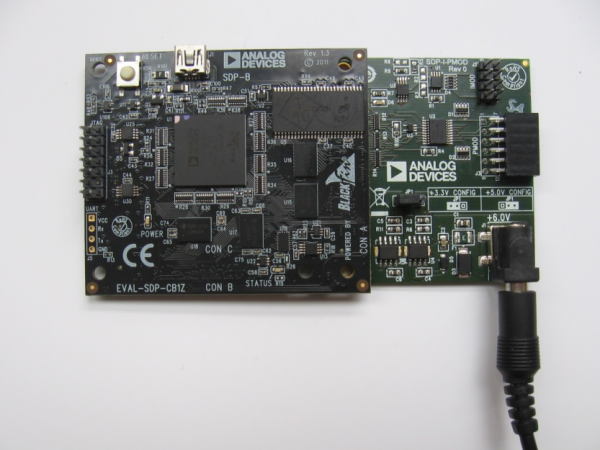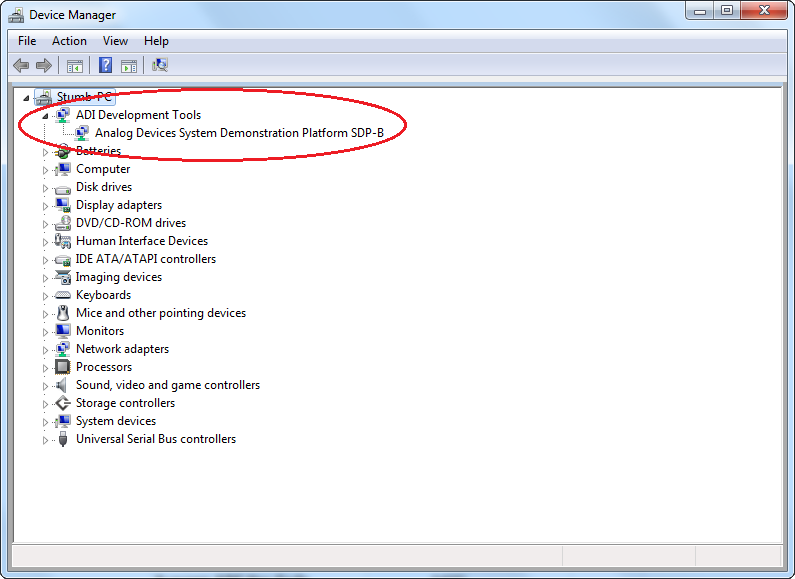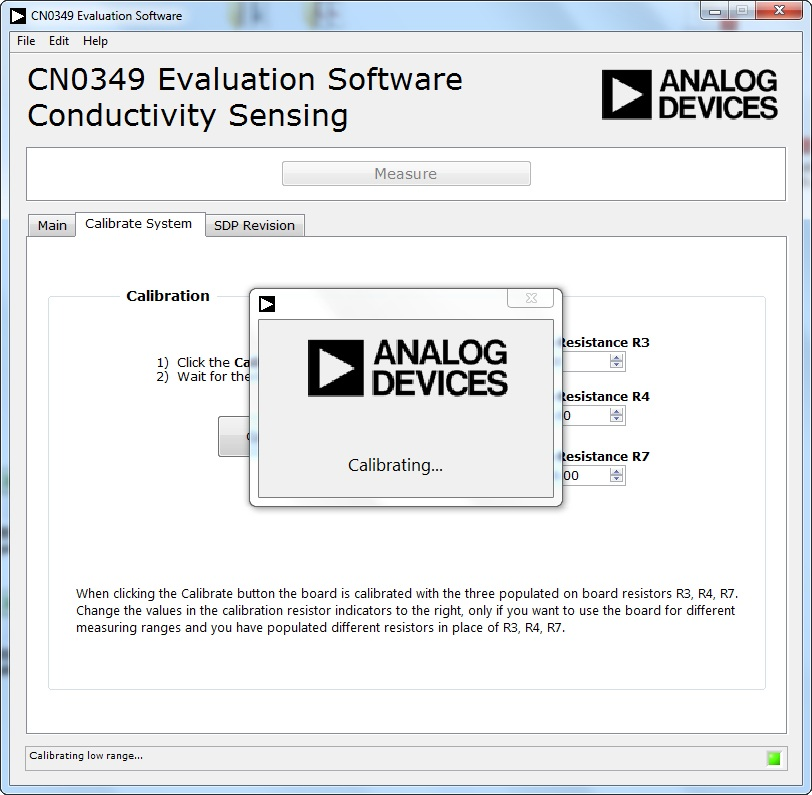
CN0349 provides robust and complete solution for processing conductivity and temperature inputs into digital code. The design solution is optimized for high precision and low cost measurement, using five active devices, and has a total error less than 1% FSR after calibration. The output of the circuit is fully isolated, and therefore, the ground-loop interference is effectively reduced, making it ideal for industrial applications.
The circuit shown in Figure 1 incorporates the AD5934YRSZ 12 bit Impedance Converter, ADG715BRUZ Octal SPST Switch, AD8606ARZ Rail-to-Rail OpAmp, ADuM5000ARWZ Isolated DC-DC Converter, ADuM1250ARZ Dual I2C Isolator, to convert the conductivity and temperature inputs to digital code.
The circuit has 8pin Digilent Pmod I2C interface connector on board, which could be used for connection to a customer microprocessor or FPGA.
The CN0349 circuit note discusses the design steps needed to optimize the circuit shown in Figure 1 for a specific measuring range including accuracy analysis and component selection considerations.
The performance of the circuit can be demonstrated with the use of Analog Devices SDP controller EVAL-SDP-CB1Z and SDP-to-PMOD Interposer Board SDP-PMD-IB1Z, both optional purchase items.
This user guide discusses the use of the evaluation software to collect data from the EVAL-CN0349-PMDZ Evaluation Board CN0349
There are several important restrictions that need to be addressed if you are developing your own application code using the EVAL-CN0349-PMDZ.
If you do not follow these requirements, your results will likely be incorrect or erroneous. You can read more about these restrictions in the CN0349 Software Recommendations section of this user guide.
Analog Devices has incorporated these restrictions into our evaluation software, which is why we won't discuss it within the Evaluation Software section of this user guide.
Figure 1. Data Acquisition system for conductivity measurements with isolation (All connections and Decoupling Not Shown)

NOTE: It is recommended that you install the CN0349 Evaluation Software to the default directory path C:\Program Files\Analog Devices\CN0349\ and all National Instruments products to C:\Program Files\National Instruments\



NOTE: It is recommended that you close all other applications before clicking “Next”. This will make it possible to update relevant system files without having to reboot your computer.
\\
It is recommended that you install the drivers to the default directory path
C:\Program Files\Analog Devices\SDP\DriversR2


—-
NOTE: Make sure that the jumper is positioned as shown below!

 }}
}} NOTE: Verify that the SDP Drivers are loaded properly. For that purpose open the Device manager and check if the SDP Board is recognized. If not repeat steps 1-3






 Inactive
Inactive Busy
Busy Error
Error Waiting for user action
Waiting for user action
NOTE: If the software was installed to the default location it will be found at
C:\Program Files\Analog Devices\CN0349\CN0349.exe



This section will describe how to use the CN0349 board with platforms other than the SDP-B platform (which will be referred to as the “host”). The host can be a MCU platform, FPGA platform, or PC with USB to I2C converter, or any type of programmable platform which has an I2C interface.
For the detailed specifications of the I2C interface, please check: I2C-bus specification. Notice that the CN0349 board does not support all the features of the I2C-bus specification, and the limitations will be described later.
The EVAL-CN0349-PMDZ evaluation board uses a standard Digilent Pmod 8pin I2C connector interface, J2, to communicate with the host. For the detailed Digilent Pmod interface specification please check: Digilent Pmod Interface Specification
| J2 Pin Number | Pin Function | Mnemonic |
|---|---|---|
| Pin 1 | Serial Clock | SCL |
| Pin 2 | Serial Clock | SCL |
| Pin 3 | Serial Data | SDA |
| Pin 4 | Serial Data | SDA |
| Pin 5 | Digital Ground | DGND |
| Pin 6 | Digital Ground | DGND |
| Pin 7 | Digital Power | VDD |
| Pin 8 | Digital Power | VDD |
The CN0349 board can accept both +3.3V±10% or +5V±10% power supplies. Please make sure the host has the same I/O level standard as the CN0349 board. The power supply for the CN0349 board minimum current requirement is 300mA. The power supply for CN0349 must provide this current with minimum voltage drop. Otherwise the permanent damage of CN0349 may occur.
For the customer platform to communicate with the CN0349 board, the I2C communication protocol must be designed carefully. The maximum I2C speed and timing is limited by the ADG715 and the AD5934. Please check the data sheet for the AD5934 and ADG715 for more specific details. The host I2C timing and speed must meet with the requirements of both the ADG715 and AD5934. The maximum I2C clock speed for ADG715 and AD5934 is 400kHz.
On the EVAL-CN0349-PMDZ evaluation board, the ADG715 I2C address is set to: 0x48, and the AD5934 I2C address is: 0x0d. Please make sure in the host I2C bus there are no devices that have same address as the ADG715 and AD5934.
When designing the software for the CN0349, there are particular register settings that must be adhered to for the AD5934 and the ADG715. These register settings will effect the input range of the individual components, as well as effect system level parameters such as the calibration and range of the entire system, so it's extremely important to follow the software settings provided below.
The hardware limitations in the CN0349 board need to be considered carefully when writing the software. If other settings for AD5934 and ADG715 outside the limits described above are used, the AD5934 ADC input must not be saturated. The AD5934 ADC reference is AVDD2=3.3V which determines the input range. The AD5934 ADC input signal amplitude is a function of the excitation voltage, the RC filter made up of R1, R5, C1, the ADG715 setting, the admittance of conductivity cell, and the AD5934 internal PGA gain settings. Incorrect results will be obtained if any of these factors cause the AD5934 ADC input signal to go out of range.
The CN0349 board MUST be calibrated before measurement. The calibration theory and calculations are located in circuit note CN0349.
| Part Number | I2C Address | Register Address | Register Data | Description |
|---|---|---|---|---|
| AD5934 | 0x0d | 0x80 | 0x01 | Excitation Voltage 2.0Vp-p, Internal PGA=1 |
| Part Number | I2C Address | I2C Data | Function | Description |
|---|---|---|---|---|
| ADG715 | 0x48 | 0x09 | High YX Range Calibration 1 | Set RFB=R9=100Ω, RCAL=R3=100Ω |
| ADG715 | 0x48 | 0x11 | High YX Range Calibration 2 | Set RFB=R9=100Ω, RCAL=R4=1kΩ |
| ADG715 | 0x48 | 0x12 | Low YX Range Calibration 1 | Set RFB=R8=1kΩ, RCAL=R4=1kΩ |
| ADG715 | 0x48 | 0x22 | Low YX Range Calibration 2 | Set RFB=R8=1kΩ, RCAL=R7=10kΩ |
| Part Number | I2C Address | I2C Data | Function | Description |
|---|---|---|---|---|
| ADG715 | 0x48 | 0x41 | Measure RTD | Set RFB=R9=100Ω, RDUT=RRTD |
| ADG715 | 0x48 | 0x81 | Measure High YX Range | Set RFB=R9=100Ω, RDUT=RCELL |
| ADG715 | 0x48 | 0x82 | Measure Low YX Range | Set RFB=R8=1kΩ, RDUT=RCELL |
There are two allowable measurement ranges for the conductivity cell admittance. If the conductivity cell admittance is out of these ranges, incorrect results may occur.
Please note: the admittance of the cell is not the conductivity of the cell, the cell constant must be used to convert the admittance to conductivity. For the details of the cell constant please check circuit note CN0349.
| Conductivity Value | Calibration | Measurement | |
|---|---|---|---|
| Low Range | 1uS to 1mS | Low YX Range Calibration 1 & 2 (see calibration table above) | Measure Low YX Range (see measurement table above) |
| High Range | 1mS to 1S | High YX Range Calibration 1 & 2 (see calibration table above) | Measure High YX Range (see measurement table above) |
Please note that the measurement result is the YX not YCELL. the details of converting YX to YCELL are give in CN0349.
Receive software update notifications, documentation updates, view the latest videos, and more when you register your hardware. Register to receive all these great benefits and more!
End of Document